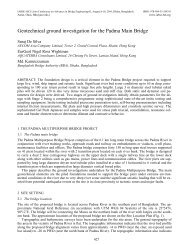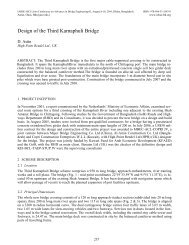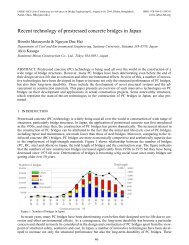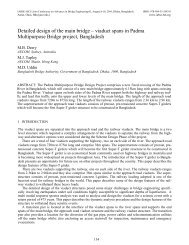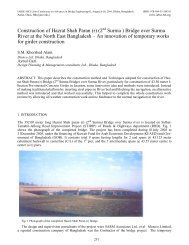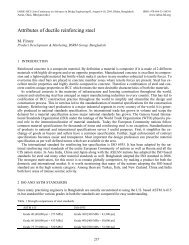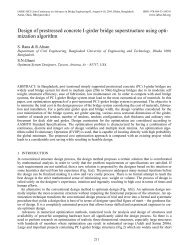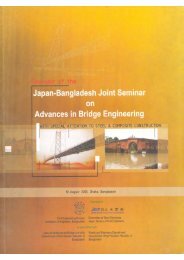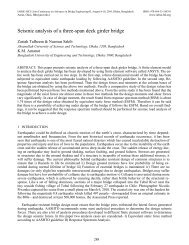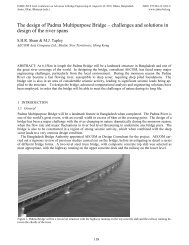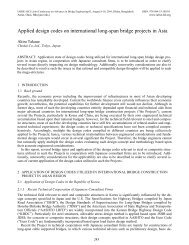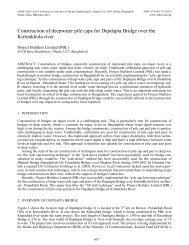Effect of bridge pier on waterways constriction - Bangladesh Group ...
Effect of bridge pier on waterways constriction - Bangladesh Group ...
Effect of bridge pier on waterways constriction - Bangladesh Group ...
You also want an ePaper? Increase the reach of your titles
YUMPU automatically turns print PDFs into web optimized ePapers that Google loves.
Figure 3.5: Simulated cross secti<strong>on</strong>s al<strong>on</strong>g with surveyed bed level at different stage <str<strong>on</strong>g>of</str<strong>on</strong>g> extreme flood event at 700 m downstream<br />
<str<strong>on</strong>g>of</str<strong>on</strong>g> the <str<strong>on</strong>g>bridge</str<strong>on</strong>g><br />
4 CONCLUSION<br />
From this study it can be anticipated that if the water ways become c<strong>on</strong>strict, bank erosi<strong>on</strong> and scour bey<strong>on</strong>d<br />
expected may be happened. To avoid this drastic situati<strong>on</strong>, river training work from 1km upstream to 1 km<br />
downstream may be recommended and c<strong>on</strong>tinuous m<strong>on</strong>itoring should be c<strong>on</strong>ducted during and after c<strong>on</strong>structi<strong>on</strong><br />
<str<strong>on</strong>g>of</str<strong>on</strong>g> such type <str<strong>on</strong>g>of</str<strong>on</strong>g> structure at stated situati<strong>on</strong>.<br />
5 LIMITATIONS<br />
The study output was <strong>on</strong>ly bed level change and bank erosi<strong>on</strong>. There were differences in water level as well<br />
as current speed. The outcome <str<strong>on</strong>g>of</str<strong>on</strong>g> the study is based <strong>on</strong> existing c<strong>on</strong>diti<strong>on</strong> <str<strong>on</strong>g>of</str<strong>on</strong>g> Surma river. The approach may<br />
be same for all river but possibility <str<strong>on</strong>g>of</str<strong>on</strong>g> deviati<strong>on</strong> exists in the case <str<strong>on</strong>g>of</str<strong>on</strong>g> other base c<strong>on</strong>diti<strong>on</strong> and other rivers. The<br />
result also varied with soil c<strong>on</strong>diti<strong>on</strong>, current speed, wave acti<strong>on</strong>, tidal acti<strong>on</strong>, surface run<str<strong>on</strong>g>of</str<strong>on</strong>g>f and so <strong>on</strong>.<br />
6 REFERENCES<br />
FAP 6, April 1993, Pre-feasibility Study <str<strong>on</strong>g>of</str<strong>on</strong>g> Upper Surma-Kushiyara Project.<br />
FAP 6, December 1993, Surma-Kushiyara-Bualai Basin Project.<br />
FAP 6, December 1994, Northeast regi<strong>on</strong>al water Management Project,<br />
Special Study, River sedimentati<strong>on</strong> and morphology, Final Report.<br />
IWM, March 2007,Mathematical Modelling al<strong>on</strong>g with Hydrological Studies and Terrestrial Survey under<br />
the Haor Rehabilitati<strong>on</strong> Scheme,Final Report.<br />
IUCN, 2005, Hydro-Meteorological Characteristics <str<strong>on</strong>g>of</str<strong>on</strong>g> Hakaluki Haor<br />
376



